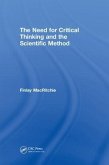Robyn M Gillies
Inquiry-Based Science Education
Robyn M Gillies
Inquiry-Based Science Education
- Gebundenes Buch
- Merkliste
- Auf die Merkliste
- Bewerten Bewerten
- Teilen
- Produkt teilen
- Produkterinnerung
- Produkterinnerung
Challenges educators to reconsider the approaches used to support student learning in the classroom. This thought-provoking volume presents research evidence to support arguments and provides teachers with frameworks within which they can embed new approaches in ways that support student development in academic and transferable contexts.
Andere Kunden interessierten sich auch für
![Hark, Hark! Hear the Story of a Science Educator Hark, Hark! Hear the Story of a Science Educator]() Jazlin EbenezerHark, Hark! Hear the Story of a Science Educator79,99 €
Jazlin EbenezerHark, Hark! Hear the Story of a Science Educator79,99 €![Advancing Professional Development Through Cpe in Public Health Advancing Professional Development Through Cpe in Public Health]() Ira NurmalaAdvancing Professional Development Through Cpe in Public Health80,99 €
Ira NurmalaAdvancing Professional Development Through Cpe in Public Health80,99 €![The Need for Critical Thinking and the Scientific Method The Need for Critical Thinking and the Scientific Method]() Finlay MacritchieThe Need for Critical Thinking and the Scientific Method206,99 €
Finlay MacritchieThe Need for Critical Thinking and the Scientific Method206,99 €![Empowering Peace and Justice Education Empowering Peace and Justice Education]() Julie LillieEmpowering Peace and Justice Education189,99 €
Julie LillieEmpowering Peace and Justice Education189,99 €![The Australian Policy Handbook The Australian Policy Handbook]() Catherine AlthausThe Australian Policy Handbook174,99 €
Catherine AlthausThe Australian Policy Handbook174,99 €![American Manifesto American Manifesto]() Bob GarfieldAmerican Manifesto17,99 €
Bob GarfieldAmerican Manifesto17,99 €![Lessons in Elementary Chemistry, Inorganic and Organic Lessons in Elementary Chemistry, Inorganic and Organic]() Lessons in Elementary Chemistry, Inorganic and Organic43,99 €
Lessons in Elementary Chemistry, Inorganic and Organic43,99 €-
-
-
Challenges educators to reconsider the approaches used to support student learning in the classroom. This thought-provoking volume presents research evidence to support arguments and provides teachers with frameworks within which they can embed new approaches in ways that support student development in academic and transferable contexts.
Hinweis: Dieser Artikel kann nur an eine deutsche Lieferadresse ausgeliefert werden.
Hinweis: Dieser Artikel kann nur an eine deutsche Lieferadresse ausgeliefert werden.
Produktdetails
- Produktdetails
- Verlag: CRC Press
- Seitenzahl: 122
- Erscheinungstermin: 11. Februar 2020
- Englisch
- Abmessung: 218mm x 145mm x 13mm
- Gewicht: 272g
- ISBN-13: 9780367279233
- ISBN-10: 0367279231
- Artikelnr.: 58730083
- Herstellerkennzeichnung
- Libri GmbH
- Europaallee 1
- 36244 Bad Hersfeld
- gpsr@libri.de
- Verlag: CRC Press
- Seitenzahl: 122
- Erscheinungstermin: 11. Februar 2020
- Englisch
- Abmessung: 218mm x 145mm x 13mm
- Gewicht: 272g
- ISBN-13: 9780367279233
- ISBN-10: 0367279231
- Artikelnr.: 58730083
- Herstellerkennzeichnung
- Libri GmbH
- Europaallee 1
- 36244 Bad Hersfeld
- gpsr@libri.de
Professor Robyn Gillies has worked extensively in both primary and secondary schools to embed STEM education initiatives into the science curriculum. This includes helping teachers to embed inquiry skills into the science curricula so they capture students' interests, provide opportunities for them to explore possible solutions to problems, explain phenomena, elaborate on potential outcomes, and evaluate findings. Professor Gillies is a Chief Investigator on the Science of Learning Research Centre (SLRC), her recommendations on how teachers can translate research into practice have been widely profiled in the international literature and on the website of the Smithsonian Science Education Center in Washington, DC.
Chapter 1: Inquiry-based science
BACKGROUND
INQUIRY-BASED SCIENCE
USING INQUIRY-BASED SCIENCE TO CHALLENGE THINKING
Cooperative Learning Activities
Strategies to help students learn to work cooperatively together
Group size
Group composition.
Type of task
Individual reflection activity
Group's Action Plan
Characteristics of Complex Tasks
CHALLENGES IMPLEMENTING INQUIRY-BASED SCIENCE
CHAPTER SUMMARY
ADDITIONAL READINGS
Chapter 2: Visual, embodied and language representations in teaching
inquiry based-science: A case study
INTRODUCTION
TYPES OF REPRESENTATIONS
Purpose of the case study
METHOD
Context for the study
Inquiry-based science unit
Data collection
Teacher measures
RESULTS AND DISCUSSION
The inquiry-based science lessons
Lesson 1: Engage
Lesson 2: Explore
Lesson 3: Explain
Lesson 4: Elaborate
Lesson 5: Evaluate
CHAPTER SUMMARY
ADDITIONAL READINGS
Chapter 3: Developing scientific literacy
INTRODUCTION
BACKGROUND
SCIENTIFIC LITERACY
Questions that challenge children's understandings
Question Stems and Cognitive Processes
The discourse of science
Encouraging audience participation
Linguistic Tools that promote student discussion
Accountable Talk
Exploratory Talk
Philosophy for Children (P4C)
CHAPTER SUMMARY
ADDITIONAL READINGS
Chapter 4: Promoting scientific discourse
INTRODUCTION
DIALOGIC TEACHING
Example of Dialogic Teaching
Dialogic interactions in a cooperative group setting
STRATEGIES TO PROMOTE DIALOGIC INTERACTIONS
DIALOGIC STRATEGIES FOR STUDENTS
Critical Thinking Skills
CHAPTER SUMMARY
ADDITIONAL READINGS
Chapter 5: Structuring cooperative learning to promote social and academic
learning
INTRODUCTION
COOPERATIVE LEARNING
BENEFITS OF COOPERATIVE LEARNING
Advantages of small, cooperative group instruction
Types of cooperative learning groups
KEY ELEMENTS IN COOPERATIVE LEARNING
Skills that Facilitate Interpersonal Communication
STRATEGIES FOR CONSTRUCTING COOPERATION IN GROUPS
STRATEGIES FOR ASSESSING COOPERATIVE LEARNING
CHAPTER SUMMARY
ADDITIONAL READINGS
Chapter 6: The Structure of Observed Learning Outcomes (SOLO) Taxonomy:
Assessing students' reasoning, problem-solving and learning
INTRODUCTION
THE SOLO TAXONOMY
FIVE LEVELS OF THE SOLO TAXONOMY
INTENDED LEARNING OUTCOMES
Examples of the increasing complexity in students' language: Using the SOLO
Taxonomy
CHAPTER SUMMARY
ADDITIONAL READINGS
BACKGROUND
INQUIRY-BASED SCIENCE
USING INQUIRY-BASED SCIENCE TO CHALLENGE THINKING
Cooperative Learning Activities
Strategies to help students learn to work cooperatively together
Group size
Group composition.
Type of task
Individual reflection activity
Group's Action Plan
Characteristics of Complex Tasks
CHALLENGES IMPLEMENTING INQUIRY-BASED SCIENCE
CHAPTER SUMMARY
ADDITIONAL READINGS
Chapter 2: Visual, embodied and language representations in teaching
inquiry based-science: A case study
INTRODUCTION
TYPES OF REPRESENTATIONS
Purpose of the case study
METHOD
Context for the study
Inquiry-based science unit
Data collection
Teacher measures
RESULTS AND DISCUSSION
The inquiry-based science lessons
Lesson 1: Engage
Lesson 2: Explore
Lesson 3: Explain
Lesson 4: Elaborate
Lesson 5: Evaluate
CHAPTER SUMMARY
ADDITIONAL READINGS
Chapter 3: Developing scientific literacy
INTRODUCTION
BACKGROUND
SCIENTIFIC LITERACY
Questions that challenge children's understandings
Question Stems and Cognitive Processes
The discourse of science
Encouraging audience participation
Linguistic Tools that promote student discussion
Accountable Talk
Exploratory Talk
Philosophy for Children (P4C)
CHAPTER SUMMARY
ADDITIONAL READINGS
Chapter 4: Promoting scientific discourse
INTRODUCTION
DIALOGIC TEACHING
Example of Dialogic Teaching
Dialogic interactions in a cooperative group setting
STRATEGIES TO PROMOTE DIALOGIC INTERACTIONS
DIALOGIC STRATEGIES FOR STUDENTS
Critical Thinking Skills
CHAPTER SUMMARY
ADDITIONAL READINGS
Chapter 5: Structuring cooperative learning to promote social and academic
learning
INTRODUCTION
COOPERATIVE LEARNING
BENEFITS OF COOPERATIVE LEARNING
Advantages of small, cooperative group instruction
Types of cooperative learning groups
KEY ELEMENTS IN COOPERATIVE LEARNING
Skills that Facilitate Interpersonal Communication
STRATEGIES FOR CONSTRUCTING COOPERATION IN GROUPS
STRATEGIES FOR ASSESSING COOPERATIVE LEARNING
CHAPTER SUMMARY
ADDITIONAL READINGS
Chapter 6: The Structure of Observed Learning Outcomes (SOLO) Taxonomy:
Assessing students' reasoning, problem-solving and learning
INTRODUCTION
THE SOLO TAXONOMY
FIVE LEVELS OF THE SOLO TAXONOMY
INTENDED LEARNING OUTCOMES
Examples of the increasing complexity in students' language: Using the SOLO
Taxonomy
CHAPTER SUMMARY
ADDITIONAL READINGS
Chapter 1: Inquiry-based science
BACKGROUND
INQUIRY-BASED SCIENCE
USING INQUIRY-BASED SCIENCE TO CHALLENGE THINKING
Cooperative Learning Activities
Strategies to help students learn to work cooperatively together
Group size
Group composition.
Type of task
Individual reflection activity
Group's Action Plan
Characteristics of Complex Tasks
CHALLENGES IMPLEMENTING INQUIRY-BASED SCIENCE
CHAPTER SUMMARY
ADDITIONAL READINGS
Chapter 2: Visual, embodied and language representations in teaching
inquiry based-science: A case study
INTRODUCTION
TYPES OF REPRESENTATIONS
Purpose of the case study
METHOD
Context for the study
Inquiry-based science unit
Data collection
Teacher measures
RESULTS AND DISCUSSION
The inquiry-based science lessons
Lesson 1: Engage
Lesson 2: Explore
Lesson 3: Explain
Lesson 4: Elaborate
Lesson 5: Evaluate
CHAPTER SUMMARY
ADDITIONAL READINGS
Chapter 3: Developing scientific literacy
INTRODUCTION
BACKGROUND
SCIENTIFIC LITERACY
Questions that challenge children's understandings
Question Stems and Cognitive Processes
The discourse of science
Encouraging audience participation
Linguistic Tools that promote student discussion
Accountable Talk
Exploratory Talk
Philosophy for Children (P4C)
CHAPTER SUMMARY
ADDITIONAL READINGS
Chapter 4: Promoting scientific discourse
INTRODUCTION
DIALOGIC TEACHING
Example of Dialogic Teaching
Dialogic interactions in a cooperative group setting
STRATEGIES TO PROMOTE DIALOGIC INTERACTIONS
DIALOGIC STRATEGIES FOR STUDENTS
Critical Thinking Skills
CHAPTER SUMMARY
ADDITIONAL READINGS
Chapter 5: Structuring cooperative learning to promote social and academic
learning
INTRODUCTION
COOPERATIVE LEARNING
BENEFITS OF COOPERATIVE LEARNING
Advantages of small, cooperative group instruction
Types of cooperative learning groups
KEY ELEMENTS IN COOPERATIVE LEARNING
Skills that Facilitate Interpersonal Communication
STRATEGIES FOR CONSTRUCTING COOPERATION IN GROUPS
STRATEGIES FOR ASSESSING COOPERATIVE LEARNING
CHAPTER SUMMARY
ADDITIONAL READINGS
Chapter 6: The Structure of Observed Learning Outcomes (SOLO) Taxonomy:
Assessing students' reasoning, problem-solving and learning
INTRODUCTION
THE SOLO TAXONOMY
FIVE LEVELS OF THE SOLO TAXONOMY
INTENDED LEARNING OUTCOMES
Examples of the increasing complexity in students' language: Using the SOLO
Taxonomy
CHAPTER SUMMARY
ADDITIONAL READINGS
BACKGROUND
INQUIRY-BASED SCIENCE
USING INQUIRY-BASED SCIENCE TO CHALLENGE THINKING
Cooperative Learning Activities
Strategies to help students learn to work cooperatively together
Group size
Group composition.
Type of task
Individual reflection activity
Group's Action Plan
Characteristics of Complex Tasks
CHALLENGES IMPLEMENTING INQUIRY-BASED SCIENCE
CHAPTER SUMMARY
ADDITIONAL READINGS
Chapter 2: Visual, embodied and language representations in teaching
inquiry based-science: A case study
INTRODUCTION
TYPES OF REPRESENTATIONS
Purpose of the case study
METHOD
Context for the study
Inquiry-based science unit
Data collection
Teacher measures
RESULTS AND DISCUSSION
The inquiry-based science lessons
Lesson 1: Engage
Lesson 2: Explore
Lesson 3: Explain
Lesson 4: Elaborate
Lesson 5: Evaluate
CHAPTER SUMMARY
ADDITIONAL READINGS
Chapter 3: Developing scientific literacy
INTRODUCTION
BACKGROUND
SCIENTIFIC LITERACY
Questions that challenge children's understandings
Question Stems and Cognitive Processes
The discourse of science
Encouraging audience participation
Linguistic Tools that promote student discussion
Accountable Talk
Exploratory Talk
Philosophy for Children (P4C)
CHAPTER SUMMARY
ADDITIONAL READINGS
Chapter 4: Promoting scientific discourse
INTRODUCTION
DIALOGIC TEACHING
Example of Dialogic Teaching
Dialogic interactions in a cooperative group setting
STRATEGIES TO PROMOTE DIALOGIC INTERACTIONS
DIALOGIC STRATEGIES FOR STUDENTS
Critical Thinking Skills
CHAPTER SUMMARY
ADDITIONAL READINGS
Chapter 5: Structuring cooperative learning to promote social and academic
learning
INTRODUCTION
COOPERATIVE LEARNING
BENEFITS OF COOPERATIVE LEARNING
Advantages of small, cooperative group instruction
Types of cooperative learning groups
KEY ELEMENTS IN COOPERATIVE LEARNING
Skills that Facilitate Interpersonal Communication
STRATEGIES FOR CONSTRUCTING COOPERATION IN GROUPS
STRATEGIES FOR ASSESSING COOPERATIVE LEARNING
CHAPTER SUMMARY
ADDITIONAL READINGS
Chapter 6: The Structure of Observed Learning Outcomes (SOLO) Taxonomy:
Assessing students' reasoning, problem-solving and learning
INTRODUCTION
THE SOLO TAXONOMY
FIVE LEVELS OF THE SOLO TAXONOMY
INTENDED LEARNING OUTCOMES
Examples of the increasing complexity in students' language: Using the SOLO
Taxonomy
CHAPTER SUMMARY
ADDITIONAL READINGS








